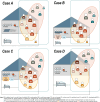Current situation, strengths and problems in intra- and interprofessional collaboration in German nursing homes - A holistic multiple case study
- PMID: 39020281
- PMCID: PMC11253382
- DOI: 10.1186/s12877-024-05182-z
Current situation, strengths and problems in intra- and interprofessional collaboration in German nursing homes - A holistic multiple case study
Abstract
Background: The increasing care complexity of nursing home residents living with dementia requires new care models that strengthen professional collaboration. To contribute to the sustainable implementation of new care models, it is important that they are linked to the care reality. However, little is known about intra- and interprofessional organization and provision of care in German nursing homes. Therefore, the aim of this study was to explore the current care situation, problems and strengths regarding intra- and interprofessional collaboration in the care of residents living with dementia.
Methods: We conducted a holistic multiple case study. The individual care units in which residents living with dementia are cared for were defined as cases. The context was built by the respective nursing homes and their regional affiliation to the federal state of North Rhine-Westphalia. We used qualitative face-to-face interviews, documents and context questionnaires for data collection. The different sources of evidence served to capture complementary perspectives and to validate the findings. First, the collected qualitative data were analyzed using deductive-inductive content analysis. Second, similarities and differences between the cases were identified to elaborate case-specific and cross-case patterns and themes. The reporting followed the EQUATOR reporting guideline for organizational case studies.
Results: We included four care units comprising 21 professionals (nurses, physicians, social worker, physiotherapist, pharmacist) and 14 relatives of residents living with dementia. The analysis revealed four categories to describe current intra- and interprofessional collaboration in all cases: actors and their roles, service delivery, coordination and governance, and communication channel. Moreover, we identified three categories that relate to the strengths and problems of intra- and interprofessional collaboration in all cases: role understanding, teamwork, and communication and exchange. Although we examined similar care units, we found differences in the realization of professional collaboration and resulting problems and strengths that are connected to the organizational contexts and strategies used.
Conclusions: Even though professional collaboration follows given patterns; these patterns do differ context-specifically and are perceived as problematic and fragmentary. Therefore, the identified differences and problems in collaboration need to be addressed in future research to develop and successfully implement tailored innovative care models.
Keywords: Case studies; Organization of care; Professional collaboration; Professional relations; Qualitative research; Residential facilities; Role development.
© 2024. The Author(s).
Conflict of interest statement
The authors declare no competing interests.
Figures
Similar articles
-
Provision of dementia-specific care in nursing homes in North Rhine-Westphalia (Germany) - analysis of person-centered practices and related problems within a holistic multiple case study.BMC Nurs. 2025 Feb 1;24(1):116. doi: 10.1186/s12912-025-02726-5. BMC Nurs. 2025. PMID: 39893497 Free PMC article.
-
Interprofessional collaboration and communication in nursing homes: a qualitative exploration of problems in medical care for nursing home residents – study protocol.J Adv Nurs. 2015 Feb;71(2):451-7. doi: 10.1111/jan.12545. Epub 2014 Oct 23. J Adv Nurs. 2015. PMID: 25338930
-
Interprofessional collaboration in nursing homes (interprof): development and piloting of measures to improve interprofessional collaboration and communication: a qualitative multicentre study.BMC Fam Pract. 2018 Jan 11;19(1):14. doi: 10.1186/s12875-017-0678-1. BMC Fam Pract. 2018. PMID: 29325541 Free PMC article.
-
Interprofessional collaboration in palliative nursing: what is the patient-family role?Int J Palliat Nurs. 2010 Jun;16(6):286-9. doi: 10.12968/ijpn.2010.16.6.48832. Int J Palliat Nurs. 2010. PMID: 20925291 Review.
-
Interprofessional collaboration in palliative dementia care.J Interprof Care. 2024 Jul-Aug;38(4):675-694. doi: 10.1080/13561820.2024.2345828. Epub 2024 May 17. J Interprof Care. 2024. PMID: 38757957 Review.
Cited by
-
Provision of dementia-specific care in nursing homes in North Rhine-Westphalia (Germany) - analysis of person-centered practices and related problems within a holistic multiple case study.BMC Nurs. 2025 Feb 1;24(1):116. doi: 10.1186/s12912-025-02726-5. BMC Nurs. 2025. PMID: 39893497 Free PMC article.
References
-
- Alzheimer Europe . Dementia in Europe Yearbook 2019: estimating the prevalence of dementia in Europe. 2020.
-
- Statistisches Bundesamt. Pflegestatistik. Pflege im Rahmen der Pflegeversicherung. Deutschlandergebnisse 2021. 2022. Available from: https://www.destatis.de/DE/Themen/Gesellschaft-Umwelt/Gesundheit/Pflege/....
-
- Bundesministerium für Gesundheit. Konzertierte Aktion Pflege. Vereinbarungstext der Arbeitsgruppen 1 bis 5. Berlin: Bundesministerium für Gesundheit; 2019.
MeSH terms
LinkOut - more resources
Full Text Sources
Medical


